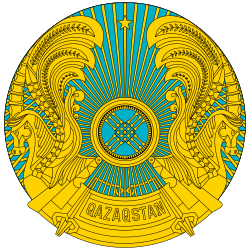| Year | No. | Article(s) affected | Main provisions | Method of adoption | Effective date | |
|---|
| 1998 | 284 | Amend articles 33, 41, 42, 44, 48, 49, 50, 51, 52, 56, 57, 66, 68, 82, 87, 91, 94, 95
Insert articles 75 | Extended presidential term from 5 to 7 years; lowered minimum age for presidential candidates; clarified bicameral Parliament powers; strengthened executive over legislature | Parliamentary approval | 7 October 1998 | [2] |
| 2007 | 254 | Amend articles 41, 42, 46, 47, 50, 51, 52, 53, 57, 61, 65–70, 71–82, 83–87, 91
Insert articles 94-1 | Reduced presidential term back to 5 years (exception for Nursultan Nazarbayev); expanded Mäjilis; Assembly of People of Kazakhstan gains 9 seats; formalized dominance of ruling party Nur Otan | Parliamentary approval | 21 May 2007 | [3] |
| 2011 | 403-IV | Insert article 41(3-1) | Allowed early presidential election in 2011; reinforced incumbent advantage | Parliamentary approval | 2 February 2011 | [4] |
| 2017 | 51-VI | Amend articles 4(3), 10(2), 39(2), 39(3), 41(2), 44(3), 44(18), 45(2), 49(1), 57(6), 61(2), 64(2), 66(1), 70(1), 72(2), 74(2), 79(3), 81, 83(1), 86(5), 87(4, 2nd sentence)
Insert articles 2(3-1), 44(10-1), 53(1-1), 66(9-1)
Remove articles 44(8, 9), 45(2), 53(3), 66(8), 73(4) | Constitutional modernization: transferred some powers from president to Parliament and Government; approval of ministers and law initiative shifted slightly; presidency remains dominant | Parliamentary approval | 10 March 2017 | [5] |
| 2019 | 238-VІ | Amend article 2(3,3-1) | Rename the capital from Astana to Nur-Sultan in honor of outgoing president Nursultan Nazarbayev | Parliamentary approval | 23 March 2019 | [6] |
| 2022 (June) | — | Amend articles 4, 6, 15, 23, 24, 44, 47, 50, 51, 52, 54, 55, 57, 58, 62, 71, 73, 74, 78, 82, 83, 87, 88, 91
Insert articles 43(3,4), 53(1-1,1-2), 56(3-1), 72(3-5), 83-1, 99
Remove articles 42(5, part excluded), 46(4 excluded), 61(5-1 excluded) | Removed Nazarbayev's status as Leader of the Nation (Elbasy); barred close relatives of president from senior offices; strengthened Parliament; restored Constitutional Court | National referendum | 8 June 2022 | [7] |
| 2022 (Sept) | 142-VII | Amend articles 2(3, 3-1), 41, 42, 71, 91(2)
Insert article 94-2 | Renaming of Nur-Sultan back to Astana; presidential term changed from 5-year renewable to 7-year single term | Parliamentary approval | 17 September 2022 | [8] |
